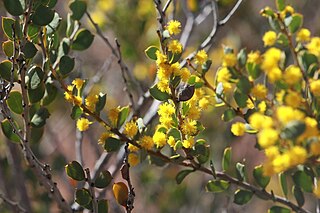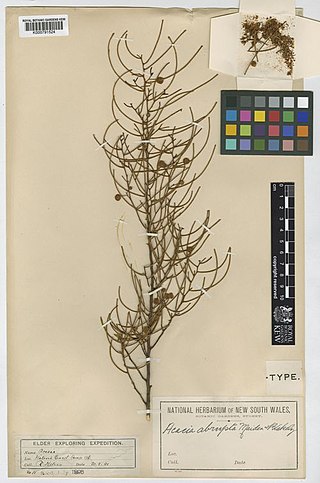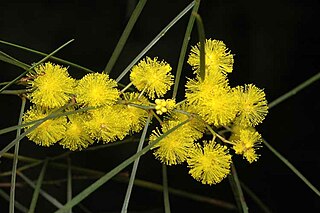
Acacia acanthoclada, commonly known as harrow wattle, is a species of flowering plant in the family Fabaceae and is endemic to southern continental Australia. It is a low, highly branched, spreading and spiny shrub with wedge-shaped to triangular or egg-shaped phyllodes with the narrower end towards the base, and spherical heads of up to 30 flowers, and linear, spirally-coiled pods.

Acacia adoxa, commonly known as the grey-whorled wattle, is a species of flowering plant in the family Fabaceae and is endemic to north-western Australia. It is a dense, low-lying shrub with linear, more or less cylindrical phyllodes in whorls of 6 to 10, heads of golden-yellow flowers, and flat, sticky pods.

Acacia hakeoides, known colloquially as hakea wattle, hakea-leaved wattle or western black wattle, is a species of flowering plant endemic to southern Australia. It is a bushy shrub or tree with lance-shaped to linear phyllodes, racemes of bright golden-yellow flowers and more or less leathery to leathery to hard and brittle pods. It can be found growing in sandy soils in semiarid and Eucalyptus woodland in the region.

Acacia aemula is a species of flowering plant in the family Fabaceae and is endemic to the south coast of Western Australia. It is an openly-branched, often prostrate, rush-like subshrub with cylindrical to more or less flat and linear phyllodes similar to its branchlets, spherical heads of cream-coloured or golden-yellow flowers and reddish-brown, thin, paper-like or crusty pods

Acacia acradenia, commonly known as Velvet Hill wattle and silky wattle, is a species of flowering plant in the family Fabaceae and is native to northern and central Australia. It is a spindly shrub or tree with elliptic or narrowly elliptic phyllodes, spikes of orange or golden flowers and linear, crustaceous pods. The Nyangumarta peoples know it as walypuna the Alyawarr call it ampwey, the Jaminjung and Ngaliwurru know it as mindiwirri, the Jaru as binbali or gundalyji, the Kaytetye as ampweye or arwele and the Warlpiri as ngardurrkura.

Acacia oncinocarpa is a shrub or tree belonging to the genus Acacia and the subgenus Juliflorae that is endemic to northern Australia.

Acacia rhodophloia, commonly known as minni ritchi or western red mulga, is a tree or shrub belonging to the genus Acacia and the subgenus Juliflorae that is endemic to a large area of arid central western Australia. The Indigenous group the Kurrama peoples know the plant as mantaru.

Acacia trachycarpa, commonly known as minni ritchi, curly-bark tree, sweet-scented minni ritchi or Pilbara minni ritchi, is a shrub or tree belonging to the genus Acacia and the subgenus Juliflorae that is native to arid and semi-arid areas of Western Australia.

Acacia acoma is a species of flowering plant in the family Fabaceae and is endemic to inland ares of south-western Western Australia. It is an erect, spindly, open or spreading shrub with variably-shaped, often narrowly oblong phyllodes, flowers arranged in spherical heads, usually arranged in pairs in leaf axils, and strongly curved or spirally coiled pods up to 15 mm (0.59 in) long when expanded.

Acacia adinophylla is a species of flowering plant in the family Fabaceae and is endemic to a small area in the south-west of Western Australia. It is a prostrate to erect, scrambling shrub with cylindrical branchlets, narrowly wedge-shaped to lance-shaped phyllodes, flowers arranged in up to 4 spherical heads of dull golden yellow flowers, and paper-like pods.

Acacia abrupta is a species of flowering plant in the family Fabaceae and is endemic to arid parts of central and western Australia. It is a spreading, glabrous, resinous shrub with linear phyllodes that are round on cross-section, heads of golden-yellow flowers, and linear pods.
Acacia adnata is a species of flowering plant in the family Fabaceae and is endemic to a small area in the south-west of Western Australia. It is a shrub with sessile, oblong, sharply pointed phyllodes, and leathery, linear pods. The flowers are unknown.

Acacia adunca, commonly known as Wallangarra wattle or cascade wattle, is a species of flowering plant in the family Fabaceae and is endemic to eastern Australia. It is an erect, bushy shrub or tree with narrowly linear phyllodes, racemes of spherical bright golden flowers, and leathery pods.

Acacia aculeatissima, commonly known as thin-leaf wattle or snake wattle, is a species of flowering plant in the family Fabaceae and is endemic to south-eastern continental Australia. It is usually a prostrate shrub with sharply pointed, needle-shaped phyllodes, flowers arranged in up to 3 more or less spherical heads of 15 to 25 flowers, and linear, papery pods up to 60 mm (2.4 in) long.

Acacia cataractae is a shrub belonging to the genus Acacia and the subgenus Juliflorae that is native to northern Australia.

Acacia curranii, also known as curly-bark wattle, is a shrub belonging to the genus Acacia and the subgenus Juliflorae that is native to north eastern Australia. It is listed as vulnerable under the Environment Protection and Biodiversity Conservation Act 1999.
Acacia gracillima is a shrub or tree belonging to the genus Acacia and the subgenus Juliflorae that is native to north western Australia.

Acacia gracilenta is a shrub belonging to the genus Acacia and the subgenus Juliflorae that is native to north Australia.

Acacia pubifolia commonly known as velvet wattle, is a flowering plant in the family Fabaceae and is endemic to northern New South Wales. It is an upright or spreading tree with bright yellow flowers.
Acacia adjutrices, commonly known as convivial wattle, is a species of flowering plant in the family Fabaceae and is endemic to a few places in the south-west of Western Australia. It is a small, multi-stemmed shrub with thin stems, mostly linear, ascending to erect phyllodes, flowers arranged in up to 4 spherical heads of golden yellow flowers, and crust-like, linear to narrowly oblong pods.



















